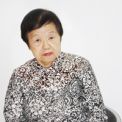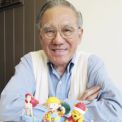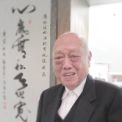-
History & Society
- Education in Pre-war Hong Kong
- History of Taikoo Sugar Refinery
- Hong Kong Products Exhibition
- Local Festivals Around the Year
- Post-war Industries
- Pre-war Industry
- The Hong Kong Jockey Club Archives
- Tin Hau Festival
- Memories We Share: Hong Kong in the 1960s and 1970s
- History in Miniature: The 150th Anniversary of Stamp Issuance in Hong Kong
- A Partnership with the People: KAAA and Post-war Agricultural Hong Kong
- The Oral Legacies (I) - Intangible Cultural Heritage of Hong Kong
- Hong Kong Currency
- Hong Kong, Benevolent City: Tung Wah and the Growth of Chinese Communities
- The Oral Legacies Series II: the Representative List of the Intangible Cultural Heritage of Hong Kong
- Braving the Storm: Hong Kong under Japanese Occupation
- A Century of Fashion: Hong Kong Cheongsam Story
Geography & EnvironmentArt & Culture- Calendar Posters of Kwan Wai-nung
- Festival of Hong Kong
- Ho Sau: Poetic Photography of Daily Life
- Hong Kong Cemetery
- Sketches by Kong Kai-ming
- The Culture of Bamboo Scaffolding
- The Legend of Silk and Wood: A Hong Kong Qin Story
- Journeys of Leung Ping Kwan
- From Soya Bean Milk To Pu'er Tea
- Applauding Hong Kong Pop Legend: Roman Tam
- 他 FASHION 傳奇 EDDIE LAU 她 IMAGE 百變 劉培基
- A Eulogy of Hong Kong Landscape in Painting: The Art of Huang Bore
- Imprint of the Heart: Artistic Journey of Huang Xinbo
- Porcelain and Painting
- A Voice for the Ages, a Master of his Art – A Tribute to Lam Kar Sing
- Memories of Renowned Lyricist: Richard Lam Chun Keung's Manuscripts
- Seal Carving in Lingnan
- Literary Giant - Jin Yong and Louis Cha
Communication & Media- Hong Kong Historical Postcards
- Shaw Brothers’ Movies
- Transcending Space and Time – Early Cinematic Experience of Hong Kong
- Remembrance of the Avant-Garde: Archival Camera Collection
- Down Memory Lane: Movie Theatres of the Olden Days
- 90 Years of Public Service Broadcasting in Hong Kong
- Multifarious Arrays of Weaponry in Hong Kong Cinema
-
History & SocietyGeography & EnvironmentArt & Culture
-
View Oral History RecordsFeatured StoriesAbout Hong Kong Voices
-
Hong Kong Memory
- Collection
- All Items
- First Generation Industrialists
Recently VisitedFirst Generation Industrialists

- Shifting from trading to manufacturing was a rare choice, Expansion of production capacity: from ...
Kwong Wing Hing, where Lai Kit Fong’s husband Lee Sai Yik used to work, was on Kwong Yuen Street East in Sheung Wan. The main commodities traded there included combs, razors, hair brushes, belts and needles from the UK. From 1950, the couple started their own trading business. However, since they did not wish to compete with their former boss at Kwong Wing Hing, they only focused on lower-bracket pacifiers which only had a narrow profit margin. At last, Lee quit his job at Kwong Wing Hing and devoted himself entirely to the manufacturing business. Lai deemed that it was a rare case for someone to change from trading to manufacturing in those days. Many of their colleagues preferred working under a boss. The couple’s first ever factory was located on the third floor of 7 Jervois Street, and was named Chun Fat Plastic Products Factory. At that time, the couple had already learnt the way to operate the injection moulding machine. There was only one set of machine in the entire factory. At first, Chun Fat bought raw materials in small logs and settled their payment in cash.
When the Korean War ended, the price of plastic dropped significantly. The Americans buyers were not aware of the decreasing price of plastic, and thus didn’t request for a corresponding reduction in charges. They instead concluded the transaction by paying the price quoted at the time when the order was placed. Factories like Chun Fat made a handsome profit consequently. In those years, the contracts between foreign clients and Hong Kong factories usually favoured the latter. If the prices of raw materials increased, the factories would be compensated. On the other hand, if the prices dropped, the factories were not asked to reduce the price accordingly. To meet with the continued expansion in business scale, Chun Fat moved to a new site in To Kwa Wan where they could find lower rent and a good supply of labour. The old site on Jervois Street was transformed into a packaging workshop. Coolies were hired to haul the products across from Kowloon each day. Chun Fat moved again to Sai Cheung Street next to other plastic factories because To Kwa Wan was after all not too convenient a place in terms of transportation. At the outset, it was mainly the Indian firms on Bonham Strand that tendered orders to Chun Fat. The factories began to manufacture as soon as orders were placed. The export of pacifiers in those days was doing quite well.
Around the 1950s and 1960s, Hong Kong factories depended on foreign orders. Sometimes the factories had to carry product samples and travel to the hongs to meet clients. At times, the clients themselves would bring samples to the factories and ask for quotations. It was not common for factories to design samples, rather, they would buy ready-made samples and alter them to prevent copyright disputes. Lee was responsible for buying samples according to the clients’ requirements and he hired artisans to forge the moulds. The first type of product they made was a cosmetic kit which was then very popular in the USA. Hongs such as Wah Hing Hong and Yick Shing tendered a good number of orders to Chun Fat. Lee would confer with other factory owners to agree on a division of specialty on product types among themselves before negotiating with the hongs. Chun Fat specialized in pacifiers until the end of the 1960s. In the very beginning, most of the factory’s operational matters like production, management and training were all handled by Lai. Her position was equivalent to a general manger and a factory director combined. Fabric trading had been Lai’s family business. Being a senior management personnel, her father taught Lai the business knowledge making her a great hand to her husbands’ career.

- Rough Start for First-generation Plastic Factory Owners
With the exception of rich Shanghainese industrialists, most Hong Kong-based toy manufacturers in the 1950s came from a humble background. Constrained by a lack of fund, technology and experience, they struggled to keep their business survived. Lam tried his best to help his industrial partners to solve their cash flow problem, so that they could get through dire situations. In the early days, the manufacturers usually raised money from their relatives before resorting to borrow from load sharks. They spent the money on running their businesses and sending their children abroad for school so that the children might come home and set up their own enterprises as well. Lam cited the examples of four of his industrial partners to show how early Hong Kong industrialists were zealous and were reliant upon each other to tackle the difficulties with limited cash flow.
1) When Lam was working at Yuen Hing Hong Co. Ltd, a factory owner, named Tong, established a factory on Wai Ching Street with several Three-Quarter Ounce Injection Moulding Machines. Tong once purchased 100 pounds of materials from Yuen Hing Hong but was not able to pay the balance of 300 dollars on time. Lam lent his whole month’s salary to Tong to pay for the materials without the knowledge of his own boss.2) The father of Wo Foo Group’s Chairman Joseph Lee came to Hong Kong from Ningbo, and built a hut out of iron boards at the bottom of Lee Garden. There, he boiled rosin in barrels and sold them to mahjong houses.3) The father of the chairman of the Federation of Hong Kong Industries Cliff Sun arrived in Hong Kong from Ningbo after the war, and rented half of a shop on Shantung Road, where he worked as a mechanic. He did not have the resource to install a telephone.4) A certain factory owner from Tianjin, who worked at Dah Chung Manufacturing Co. Ltd before, settled down on Yu Chau Street and installed four sets of Three-Quarter Ounce Injection Moulding Machines. These moulding machines could only produce products below the weight of 0.75 ounce. Once he was not able to pay the rent of 500 dollars, and Lam lent him 2 months’ salary so that he could get through the hard time.

- Yangtzekiang Garment Mfrs developed production lines for suits and explored American market
Yangtzekiang Garment Mfrs first made shirts, and then produced trousers and outer garments. In the early 1960s, Yangtzekiang developed suits business, the first of its kind in the local garment manufacturing industry. In those years, suits were usually tailor made but not produced by garment manufacturers. Amidst the Asian garment manufacturers, South Korea took an early step to produce suits for exporting to the USA. In order to expand his business, S.K. Chan hired a skilled master from the USA and set up production lines for suits. The master came from a US garment factory and was paid 700 dollars per day by Yangtzekiang, earning over 20 thousand dollars a month. In contrast, S.K. Chan was just receiving a monthly salary of over 1000 dollars as a managing director. In addition to the American master, Yangtzekiang also had local tailors as consultants. The making of suits differed from that of shirts and trousers in the procedures of collar tailoring and buttonhole opening. Yangtzekiang opened a suits department in its Mong Kok Road factory. Machines specifically used for making suits were bought. Sewists were re-trained. A suits outlet was set up in Entertainment Building in Central and salespersons were hired to promote the suits. Meanwhile, S.K. Chan was developing the US market. He adopted his salespersons’ suggestion and opened an outlet in the USA, becoming one of the first Hong Kong manufacturers selling garments in the USA. Thanks to the success of their outlets in the 1960s, Yangtzekiang created their own brand Michel René, and then went all out to acquire famous fashion brands in the USA and Europe, creating a flourishing retail business.

- Textile industry in an indsutralist's eyes
Ha Chung Fong had a profound relationship with the textile industry. The Textile industry was highly diversified. From dyes and fabrics, many experts have spent extensive effort in improving the techniques involved. The improvement in synthetics and chemicals helped the advancement in society. Textile industry involved the knowledge of chemical, weaving and knitting techniques and the understanding of machinery. Professionals in these fields were constantly required in the industry. Textile industry first started in Europe, and then Japan, before coming to Hong Kong, Taiwan and South Korea. Textile industry contributed to the growth of a society. It was one of the basic components of an industrialized country. With textile industry providing a solid foundation, a country could develop other industries. Taking India as an example, the country's textile industry provided the impetus for its animal husbandry, and sericulture for harvesting silk. The plantation of cotton had also helped the development of agriculture. Thus textile industry was interconnected with other industries such as livestock and agriculture, providing essential job opportunities for a society.

- Upholding the development of plastic processing industry
Tins’ Chemical and low-end manufacturers (1). When KP Tin first ran his factory in Hong Kong, he produced only plastic films but no more resin products. The cost of opening and operating the factory mainly came from his savings. Although he had the support from raw material vendors and banks, he relied mainly on his own finance. In 1962, Tins' Chemical Industrial Co Ltd (the former company of which was Thian’s Plastic Factory, referred to as Tins’) erected an industrial building at Lai Chi Kok Road, Cheung Sha Wan and rented it to the processing factories that purchased Tins’ films. Warehouses for plastics were on the lower floors while workshops for material preparation and silk printing were on the upper floors. With all the supporting facilities combined transport and storage costs for low-end manufacturers were reduced, and thus facilitating the development of low-end industries as well as their competition against their Taiwan counterparts.
Hong Kong Government’s industrial and commercial representatives promoted for Tins’ overseas. At the same time, Tins’ ran a showroom at Bonham Strand East, displaying the products and contacts of low-end manufacturers. On a cheap price, Tins’ provided middle-man services to help the processing factories promote their businesses. Prior to the set-up of the Tins’ plant, local plastic processing factories imported films from Japan and Taiwan. The plastics produced locally by the Tins’ benefited the local plastic processing industry. The films KP Tin produced in Hong Kong had been greatly improved from the ones made in Indonesia. Tins’ films were slightly better than the Taiwan products and slightly poorer than the Japanese ones. Local manufacturers were not demanding over plastics (except for gas-filled dolls). What really mattered was the processing procedures themselves.
Tins’ Chemical and low-end manufacturers (2). When KP Tin first came to Hong Kong, the local plastic industry was not well developed given the dear land prices and undeveloped foreign trade. Overseas representatives of the Commerce and Industry Department invited foreign businessmen to Hong Kong and referred local manufacturers to the foreign businessmen for the purchase of raw materials. In 1962, KP Tin bought a site at Lai Chi Kok Road and turned it to an industrial building. It was leased to processing manufacturers on a low price. It came with a workshop for material preparation, which plastics were tailored for the manufacturers before they were outsourced to the households in the resettlement estates for the next procedures. Transportation in Tuen Mun was inconvenient in those days. KP Tin bought land and built an industrial building in Cheung Sha Wan and brought the processing manufacturers together for better cooperation among themselves. Finished products processed from Tins’ films included toys, gas-filled dolls, big water-filled bed, school bags, pencils and stationeries. The artificial leather made by Tins’ at a rather late stage. It could be used for making raincoats, coats, travelling bags, handbags, etc. With the continuous introductions of new raw materials by vendors, and with the new technology acquired from KP Tin’s trips abroad, Tins’ plastics underwent some breakthroughs and had wider applications gradually. The raw materials used by Tins’ included PVC powder, stabilizers and others, which came from countries like Japan and Germany.
Copyright © 2012 Hong Kong Memory. All rights reserved.
| Set Name |





